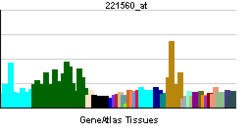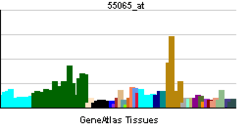MARK4
MAP/microtubule affinity-regulating kinase 4 is an enzyme that in humans is encoded by the MARK4 gene.[1][2][3]
Interactions
MARK4 has been shown to interact with USP9X[4] and Ubiquitin C.[4]
References
- ↑ Kato T, Satoh S, Okabe H, Kitahara O, Ono K, Kihara C et al. (Apr 2001). "Isolation of a novel human gene, MARKL1, homologous to MARK3 and its involvement in hepatocellular carcinogenesis". Neoplasia 3 (1): 4–9. doi:10.1038/sj/neo/7900132. PMC 1505019. PMID 11326310.
- ↑ Drewes G, Ebneth A, Preuss U, Mandelkow EM, Mandelkow E (May 1997). "MARK, a novel family of protein kinases that phosphorylate microtubule-associated proteins and trigger microtubule disruption". Cell 89 (2): 297–308. doi:10.1016/S0092-8674(00)80208-1. PMID 9108484.
- ↑ "Entrez Gene: MARK4 MAP/microtubule affinity-regulating kinase 4".
- ↑ 4.0 4.1 Al-Hakim AK, Zagorska A, Chapman L, Deak M, Peggie M, Alessi DR (Apr 2008). "Control of AMPK-related kinases by USP9X and atypical Lys(29)/Lys(33)-linked polyubiquitin chains". Biochem. J. 411 (2): 249–60. doi:10.1042/BJ20080067. PMID 18254724.
Further reading
- Nagase T, Nakayama M, Nakajima D, Kikuno R, Ohara O (2001). "Prediction of the coding sequences of unidentified human genes. XX. The complete sequences of 100 new cDNA clones from brain which code for large proteins in vitro.". DNA Res. 8 (2): 85–95. doi:10.1093/dnares/8.2.85. PMID 11347906.
- Beghini A, Magnani I, Roversi G, Piepoli T, Di Terlizzi S, Moroni RF et al. (2003). "The neural progenitor-restricted isoform of the MARK4 gene in 19q13.2 is upregulated in human gliomas and overexpressed in a subset of glioblastoma cell lines.". Oncogene 22 (17): 2581–91. doi:10.1038/sj.onc.1206336. PMID 12735302.
- Trinczek B, Brajenovic M, Ebneth A, Drewes G (2004). "MARK4 is a novel microtubule-associated proteins/microtubule affinity-regulating kinase that binds to the cellular microtubule network and to centrosomes.". J. Biol. Chem. 279 (7): 5915–23. doi:10.1074/jbc.M304528200. PMID 14594945.
- Brajenovic M, Joberty G, Küster B, Bouwmeester T, Drewes G (2004). "Comprehensive proteomic analysis of human Par protein complexes reveals an interconnected protein network.". J. Biol. Chem. 279 (13): 12804–11. doi:10.1074/jbc.M312171200. PMID 14676191.
- Schneider A, Laage R, von Ahsen O, Fischer A, Rossner M, Scheek S et al. (2004). "Identification of regulated genes during permanent focal cerebral ischaemia: characterization of the protein kinase 9b5/MARKL1/MARK4.". J. Neurochem. 88 (5): 1114–26. doi:10.1046/j.1471-4159.2003.02228.x. PMID 15009667.
- Rual JF, Venkatesan K, Hao T, Hirozane-Kishikawa T, Dricot A, Li N et al. (2005). "Towards a proteome-scale map of the human protein-protein interaction network.". Nature 437 (7062): 1173–8. doi:10.1038/nature04209. PMID 16189514.
- Wissing J, Jänsch L, Nimtz M, Dieterich G, Hornberger R, Kéri G et al. (2007). "Proteomics analysis of protein kinases by target class-selective prefractionation and tandem mass spectrometry.". Mol. Cell Proteomics 6 (3): 537–47. doi:10.1074/mcp.T600062-MCP200. PMID 17192257.
| |||||||||||||||||||||||||||||||||||||||||||||||||||||||||||||||||||||||||||||||||||||||||||||||||||||||||||||||||||||||||||||||||||||||||||||||||||||||||||||||||

